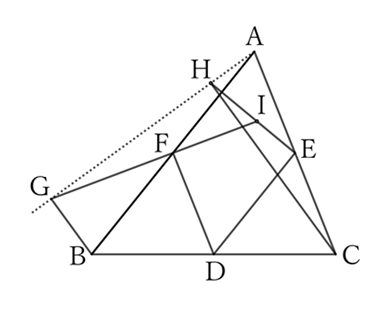Let the midpoints of sides $BC, \ CA$ and $AB$ of a triangle $ABC$ be $D, \ E$ and $F$, respectively.
Also, let $G$ and $H$ be the feet of perpendiculars drawn from $B$ and $C$ to any line passing through $A$, respectively, and $I$ be the intersection point of $EH$ and $FG$, or their extensions.
Then $∠EIF$ or its supplementary angle is equal to $∠EDF$.
$\downarrow$ $\downarrow$ $\downarrow$ $\downarrow$ $\downarrow$
$$ $$Solution


For right-angled triangles $ABG$ and $ACH$, $F$ and $E$ are the midpoints of the hypotenuses.
Thus, from the diagram above,
$$∠FGA=∠FAG. \qquad [1]$$
$$∠AHE=∠CAH,$$
$$∴ \ ∠IHG=∠CAH. \qquad [2]$$
Or, from the diagram below,
$$∠CAH+∠ACH=∠R,$$
$$∠IHG=∠R+∠ACH, \qquad (∵ \ ∠EHC=∠ACH)$$
$$∴ \ ∠IHG=2∠R-∠CAH. \qquad [2]’$$
For the diagram above, if we add up $[1]$ and $[2]$,
$$∠FGA+∠IHG=∠FAG+∠CAH,$$
$$∴ \ ∠EIF=∠A.$$
However, since the quadrilateral $AEDF$ is a parallelogram,
$$∠A=∠EDF,$$
$$∴ \ ∠EIF=∠EDF. \qquad [3]$$
When $[1]$ and $[2]’$ are added together in the diagram below,
$$∠FGA+∠IHG=∠FAG+2∠R-∠CAH,$$
$$∴ ∠EIF=2∠R-(∠CAH-∠FAG),$$
$$∴ \ ∠EIF=2∠R-∠A.$$
However, since the quadrilateral $AEDF$ is a parallelogram,
$$∠A=∠EDF,$$
$$∴ \ ∠EIF=2∠R-∠EDF. \qquad [4]$$
From $[3]$ and $[4]$, $∠EIF$ is equal to $∠EDF$ or its complementary angle.
Conversely, $∠EIF$ or its complement is equal to $∠EDF$.
$ $
Reference Teiichiro Sasabe (1976) The Encyclopedia of Geometry (2nd edition), Seikyo-Shinsha, p.40.